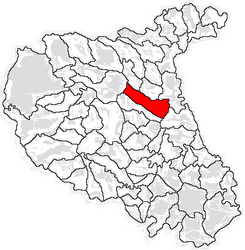Magnetic detector
The magnetic detector or Marconi magnetic detector, sometimes called the "Maggie", was an early radio wave detector used in some of the first radio receivers to receive Morse code messages during the wireless telegraphy era around the turn of the 20th century.[1][2] Developed in 1902 by radio pioneer Guglielmo Marconi[1][2][3] from a method invented in 1895 by New Zealand physicist Ernest Rutherford[4] it was used in Marconi wireless stations until around 1912, when it was superseded by vacuum tubes.[5] It was widely used on ships because of its reliability and insensitivity to vibration. A magnetic detector was part of the wireless apparatus in the radio room of the RMS Titanic which was used to summon help during its famous 15 April 1912 sinking.[6]
History
The primitive spark gap radio transmitters used during the first three decades of radio (1886-1916) could not transmit audio (sound) and instead transmitted information by wireless telegraphy; the operator switched the transmitter on and off with a telegraph key, creating pulses of radio waves to spell out text messages in Morse code. So the radio receiving equipment of the time did not have to convert the radio waves into sound like modern receivers, but merely detect the presence or absence of the radio signal. The device that did this was called a detector. The first widely used detector was the coherer, invented in 1890. The coherer was a very poor detector, insensitive and prone to false triggering due to impulsive noise, which motivated much research to find better radio wave detectors.
Ernest Rutherford had first used the hysteresis of iron to detect Hertzian waves in 1896[4][7] by the demagnetization of an iron needle when a radio signal passed through a coil around the needle, however the needle had to be remagnetized so this was not suitable for a continuous detector.[7] Many other wireless researchers such as E. Wilson, C. Tissot, Reginald Fessenden, John Ambrose Fleming, Lee De Forest, J.C. Balsillie, and L. Tieri had subsequently devised detectors based on hysteresis, but none had become widely used due to various drawbacks.[7] Many earlier versions had a rotating magnet above a stationary iron band with coils on it.[8] This type was only periodically sensitive, when the magnetic field was changing, which occurred as the magnetic poles passed the iron.
During his transatlantic radio communication experiments in December 1902 Marconi found the coherer to be too unreliable and insensitive for detecting the very weak radio signals from long distance transmissions. It was this need that drove him to develop his magnetic detector. Marconi devised a more effective configuration with a moving iron band driven by a clockwork motor passing by stationary magnets and coils, resulting in a continuous supply of iron that was changing magnetization, and thus continuous sensitivity (Rutherford claimed he had also invented this configuration).[8] The Marconi magnetic detector was the "official" detector used by the Marconi Company from 1902 through 1912, when the company began converting to the Fleming valve and Audion-type vacuum tubes. It was used through 1918.
Description
See drawing at right. The Marconi version consisted of an endless iron band (B) built up of 70 strands of number 40 gage silk-covered iron wire. In operation, the band passes over two grooved pulleys rotated by a wind-up clockwork motor.[1][2] The iron band passes through the center of a glass tube which is close wound with a single layer along several millimeters with number 36 gage silk-covered copper wire. This coil (C) functions as the radio frequency excitation coil. Over this winding is a small bobbin wound with wire of the same gauge to a resistance of about 140 ohms. This coil (D) functions as the audio pickup coil. Around these coils two permanent horseshoe magnets are arranged to magnetize the iron band as it passes through the glass tube.[1]
작동 방식
그 장치는 철선의 자기화 이력(hysteresis)에 의해 작동된다.[1][2] 영구 자석은 철사를 따라 반대 방향으로 코일의 중심에서 각각 (또는 멀리) 향하는 두 개의 반대쪽 자기장을 생성하도록 배열되어 있다. 이것은 철 띠의 축을 따라 자성을 하는 기능을 하는데, 처음에는 코일의 중심에 접근할 때 한 방향으로 자성을 한 다음, 코일의 반대쪽에서 떠날 때 반대 방향으로 자력을 역전시킨다.[2] 철의 이력(운동성) 때문에 자성을 역전시키기 위해서는 일정한 임계 자기장(강압장 Hc)이 필요하다. 그래서 움직이는 와이어의 자화현상은 필드가 역행하는 장치의 중심에서 역행하는 것이 아니라, 두 번째 자석의 필드가 H에c 도달했을 때, 전선의 출발면을 향해 어느 정도 역행하는 것이다.[1][2] 와이어 자체가 코일을 통해 이동하지만, 무선 신호가 없을 경우 픽업 코일에 대해 자기화 "플립스"가 정지되어 있어, 플럭스 변화가 없고 픽업 코일에 전압이 유도되지 않는다.
안테나(A)의 무선 신호는 튜너에 의해 수신되고(표시되지 않음) 호기 코일 C를 통과하며, 그 반대쪽 끝은 접지(E)에 연결된다.[2] 코일의 자기장이 빠르게 역행하는 것은 강제성 H를c 초과하고 철의 이력(hysteresis)을 상쇄시켜 자기장 변화가 갑자기 철사를 중심, 즉 자기장 사이에, 즉 자기장(field)이 역행하는 방향으로 이동하게 한다.[1][2] 이는 자석을 코일에 밀어넣어 픽업 코일 D를 통과하는 자속이 변화하여 픽업 코일의 전류 펄스를 유도하는 것과 유사한 효과를 가졌다. 오디오 픽업 코일은 전화 수신기(이어폰)(T)에 연결되어 현재 펄스를 소리로 변환한다.[2]
스파크 갭 송신기의 무선 신호는 초당 수백 개 정도의 오디오 속도로 반복되는 전파(감파파)의 펄스로 구성되었다. 전파의 각 맥박은 이어폰에서 전류의 맥박을 만들어 냈기 때문에 그 신호는 이어폰에서 음악적인 음색이나 윙윙거리는 소리처럼 들렸다.[1]
기술적 세부사항
철제 띠는 케이스 내부의 메인 스프링과 클록워크 메커니즘에 의해 회전되었다. 밴드 속도에 대해 초당 1.6에서 7.5 cm의 서로 다른 값이 제시되었다. 기기가 광범위한 밴드 속도에서 작동할 수 있을 것이다.[8] 조작자는 측면의 크랭크를 이용해 메인 스프링을 감아두어야 했다. 작동자들은 때때로 감는 것을 잊어버려서 밴드가 돌아가는 것을 멈추고 검출기가 작동을 멈추곤 했고, 때로는 라디오 메시지 중간에 있었다.
검출기는 이어폰에서 배경에서 '히싱' 또는 '로잉'하는 소리로 들리는 전자 소음을 발생시켜 듣기엔 다소 피로했다.[9] 이것은 철의 바크하우젠 효과로 인한 바크하우젠 소음이었다.[9] 철선의 주어진 영역에 있는 자기장이 검출기를 통과하면서 변화함에 따라 철의 자기 영역 사이의 미세한 영역 벽이 일련의 저크로 이동하면서 철 결정 격자의 결함에 매달려 있다가 자유롭게 당겨졌다. 각 얼간이들은 코일을 통해 자기장에 미세한 변화를 일으키며, 소음을 유도했다.
출력은 직류가 아닌 오디오 교류였기 때문에, 검출기는 이어폰으로만 사용할 수 있었고, 사이펀 종이 테이프 레코더인 공동 수신기에 사용되는 일반적인 녹음 기기에는 사용할 수 없었다.[10]
기술적 견지에서 볼 때, 작동을 위해서는 몇 가지 미묘한 전제조건이 필요하다. 철 밴드에서 영구 자석의 자기장 강도는 무선 주파수 흥분 코일에 의해 생성된 전기장의 강도와 동일한 크기 순서가 되어야 하며, 무선 주파수 신호가 철의 임계 이력(동력)을 초과할 수 있어야 한다. 또한 무선 신호를 공급하는 튜너의 임피던스는 흥분 코일의 낮은 임피던스와 일치하도록 낮아야 하므로 특별한 튜너 설계 고려가 필요하다. 전화 이어폰의 임피던스는 오디오 픽업 코일의 임피던스와 대략 일치해야 하며, 이 임피던스는 수백 옴이다. 쇠띠는 초당 몇 밀리미터씩 움직인다. 자기탐지기는 1912년경부터 교체되기 시작한 플레밍 밸브만큼 민감하지는 않았지만,[1] 당시 흔히 사용하던 공동 사용자보다 훨씬 민감했다.[5]
In the Handbook Of Technical Instruction For Wireless Telegraphists by: J. C. Hawkhead (Second Edition Revised by H. M. Dowsett) on pp 175 are detailed instructions and specifications for operation and maintenance of Marconi's magnetic detector.
References
- ^ a b c d e f g h i Fleming, John Ambrose (1911). . In Chisholm, Hugh (ed.). Encyclopædia Britannica. 26 (11th ed.). Cambridge University Press. pp. 510–541, see page 536, second para, lines 8 & 9 and figure 45.
In 1902 Marconi invented two forms of magnetic detector, one of which he developed into an electric wave detector of extraordinary delicacy and utility
- ^ a b c d e f g h i Fleming, John Ambrose (1908). The Principles of Electric Wave Telegraphy. UK: Longmans, Green and Co. pp. 380–382.
- ^ Marconi, Guglielmo (1902). "Note on a magnetic detector of electric waves which can be employed as a receiver in space telegraphy". Proceedings of the Royal Society. London. 70: 341. doi:10.1098/rspl.1902.0034.
- ^ a b Rutherford, Ernest (1 January 1897). "A magnetic detector of electrical waves and some of its applications". Philosophical Transactions of the Royal Society of London. Royal Society. 189: 1–24. Bibcode:1897RSPTA.189....1R. doi:10.1098/rsta.1897.0001.
- ^ a b Wenaas, Eric P. (2007). Radiola: The Golden Age of RCA, 1919-1929. Sonoran Publishing. p. 2. ISBN 978-1886606210.
- ^ Stephenson, Parks (November 2001). "The Marconi Wireless Installation in R.M.S. Titanic". Old Timer's Bulletin. The Antique Wireless Association. 42 (4). Retrieved May 22, 2016. copied on Stephenson's marconigraph.com personal website
- ^ a b c Phillips, Vivian J. (1980). Early radio wave detectors. Peter Peregrinus, Ltd. and The Science Museum, London. pp. 85–122. ISBN 0906048249.
- ^ a b c Phillips (1980) Early radio wave detectors, p. 103-105
- ^ a b Phillips (1980) Early radio wave detectors, p. 98, 102, 106
- ^ Fleming, John Ambrose (1916). An elementary manual of radiotelegraphy and radiotelephony for students and operators, 3rd Ed. UK: Longmans, Green and Co. pp. 203, 208.
External links
 Media related to Magnetic detectors at Wikimedia Commons
Media related to Magnetic detectors at Wikimedia Commons- The Marconi magnetic detector From the book "A Handbook of Wireless Telegraphy" (1913) by J. Erskine-Murray. D.Sc.
- Magnetic detector basics






